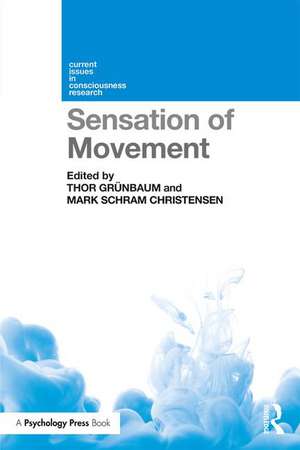Sensation of Movement: Current Issues in Consciousness Research
Editat de Thor Grünbaum, Mark Schram Christensenen Limba Engleză Paperback – 13 sep 2017
Addressing conscious sensations of movement, experimental designs and measures, and the possible functions of proprioceptive and kinaesthetic information in motor control and bodily cognition, the book advocates the integration of neuroscientific knowledge and philosophical perspectives. With an awareness of the diverse ideas and theories from these distinct fields, the book brings together leading researchers to bridge these divides and lay the groundwork for future research.
Of interest to both students and researchers of consciousness, Sensation of Movement will be essential reading for those researching motor control, multimodal perception, bodily self-recognition, and sense of agency. It aims to encourage the integration of multiple perspectives in order to arrive at new insights into how sensation of movement can be studied scientifically.
| Toate formatele și edițiile | Preț | Express |
|---|---|---|
| Paperback (1) | 375.65 lei 6-8 săpt. | |
| Taylor & Francis – 13 sep 2017 | 375.65 lei 6-8 săpt. | |
| Hardback (1) | 981.05 lei 6-8 săpt. | |
| Taylor & Francis – 13 sep 2017 | 981.05 lei 6-8 săpt. |
Preț: 375.65 lei
Nou
Puncte Express: 563
Preț estimativ în valută:
71.91€ • 73.96$ • 59.66£
71.91€ • 73.96$ • 59.66£
Carte tipărită la comandă
Livrare economică 18 februarie-04 martie
Preluare comenzi: 021 569.72.76
Specificații
ISBN-13: 9781138646339
ISBN-10: 1138646334
Pagini: 166
Ilustrații: 2 Tables, black and white; 8 Line drawings, black and white; 6 Halftones, black and white
Dimensiuni: 156 x 234 x 10 mm
Greutate: 0.28 kg
Ediția:1
Editura: Taylor & Francis
Colecția Routledge
Seria Current Issues in Consciousness Research
Locul publicării:Oxford, United Kingdom
ISBN-10: 1138646334
Pagini: 166
Ilustrații: 2 Tables, black and white; 8 Line drawings, black and white; 6 Halftones, black and white
Dimensiuni: 156 x 234 x 10 mm
Greutate: 0.28 kg
Ediția:1
Editura: Taylor & Francis
Colecția Routledge
Seria Current Issues in Consciousness Research
Locul publicării:Oxford, United Kingdom
Public țintă
PostgraduateCuprins
Acknowledgements List of figures and tables List of contributors Sensation of movement: An introduction, Thor Grünbaum and Mark Schram Christensen Part I. The content of sensations of movement I am moving my hand. Ownership, agency, and the body, Andreas Kalckert Is there a bodily experience of agency?, Myrto Mylopoulos Part II. Experimenting with agency: Measurements and designs Measuring sensation of movement, Mads Jensen, Mia Dong, Mikkel C. Vinding, and Morten Overgaard Sense of moving. Moving closer to the movement, Mark Schram Christensen and Thor Grünbaum Part III. Functions of sensations of movement Sensation of movement. A multimodal perception, Anne Kavounoudias Distorted body representations and skilled action, Matthew R. Longo A puzzle about the function of proprioception in Action, Hong Yu Wong Index
Notă biografică
Thor Grünbaum is an Associate Professor of Philosophy in the Department of Media, Cognition, and Communication at the University of Copenhagen.
Mark Schram Christensen is an Associate Professor in Cognitive Motor Neuroscience in the Department of Neuroscience and Pharmacology at the University of Copenhagen. He is also a Senior Researcher at DTU Compute in the Department of Applied Mathematics and Computer Science at the Technical University of Denmark.
Mark Schram Christensen is an Associate Professor in Cognitive Motor Neuroscience in the Department of Neuroscience and Pharmacology at the University of Copenhagen. He is also a Senior Researcher at DTU Compute in the Department of Applied Mathematics and Computer Science at the Technical University of Denmark.
Descriere
Sensation of Movement explores the role of sensation in motor control, bodily self-recognition and sense of agency. The sensation of movement is dependent on a range of information received by the brain, from signalling in the peripheral sensory organs to the establishment of higher order goals. Through the integration of neuroscientific knowledge with psychological and philosophical perspectives, this book questions whether one type of information is more relevant for the ability to sense and control movement.



